P.Bowers Curtiss Aircraft 1907-1947 (Putnam)
Model 19 - Eagle
The Eagle was a 1919 effort to produce a potential airliner for the anticipated postwar aviation boom that never materialized. Also designed by Gilmore, the Eagle used essentially the structural concept of the earlier Oriole expanded to airliner size.
Many innovations were incorporated. Six to eight passengers were seated in a properly-designed cabin with adequate windows and built-in conveniences. The two pilots were also within the cabin, a distinct departure from the converted wartime bombers and Navy flying-boats then in use as passenger carriers. A bogie type undercarriage was used, featuring two sets of tandem wheels. An unusual feature of this gear was the use of a large streamlined metal fairing to cover most of each wheel, anticipating the use of the speed-enhancing pants that came into use in 1930.
Three-engined Eagle - The first Eagle was built as a trimotor powered with 150 hp Curtiss K-6 engines and the few production models used these or the 160 hp C-6.
Twin-engined Eagle - One twin-engined Eagle, powered with 400 hp Curtiss C-12s, was built. After the near loss of this version on its first flight due to loss of power on one engine at take-off, it was decided that 800 hp was too much for the Eagle airframe.
Single-engined Eagle - A single-engined version was developed to use the 400 hp wartime Liberty engine. The US Army Air Service bought three of these for ambulance and personnel transport work and assigned Army serial numbers 64241-64243.
Eagle I
Transport. Two pilots and six passengers. Three 150 hp Curtiss K-6 or three 160 hp Curtiss C-6.
Span 61 ft 4 in (18.69 m); length 36 ft 9 in (11.2 m); height 12 ft 4 in (3.75 m); wing area 900 sq ft (83.61 sq m).
Empty weight 5.130 lb (2.327 kg): gross weight 7.450 lb (3.379 kg).
Maximum speed 107 mph (172.19 km h); climb in 10 min 4,075 ft (1.242 m): range 475 miles (764 km).
Eagle II
Transport. Two pilots and six passengers. Two 400 hp Curtiss C-12.
Span 64 ft 4 1/8 in (19.61 m): length 36 ft 7 in (11.15 m); height 12 ft 11 in (3.93 m); wing area 937 sq ft (87.04 sq m).
Empty weight 5,310 lb (2,408 kg); gross weight 8,690 lb (3,942 kg).
Maximum speed 124 mph (199.55 km/h); range 750 miles (1,207 km).
Eagle III
Transport. Pilot and nine passengers. One 400 hp Liberty 12.
Span 64 ft 4 1/8 in (19.61 m); length 37 ft 2 9/16 in (11.34 m); height 13 ft 6 1/16 in (4.11m); wing area 937 sq ft (87.04 sq m).
Empty weight 4,245 lb (1.925 kg): gross weight 7,425 lb (3,368 kg).
Maximum speed 100 mph (160.93 km/h); climb in 10 min - 5.000 ft (1.524 m).
G.Swanborough, P.Bowers United States Military Aircraft Since 1909 (Putnam)
CURTISS EAGLE
Three examples (64242/64244) of the Curtiss Eagle 10-seat cabin biplane transport were sold to the Army, but differed from the three- engined commercial model in having only a single Liberty engine in the nose. One of the Army Eagles was evaluated as a four-litter ambulance.
Span, 64 ft. 4 1/4 in.; length, 36 ft.; height, 12 ft. 11 in.; wing area, 800 sq. ft.; gross weight, 7,423 lb.; high speed, 100 m.p.h.






